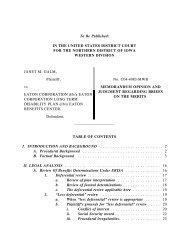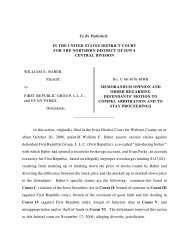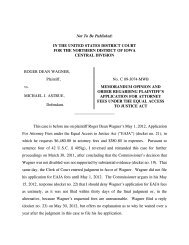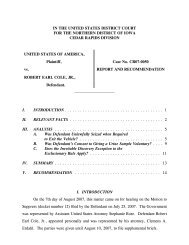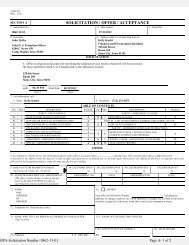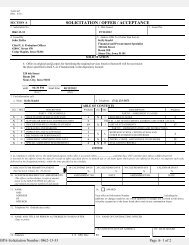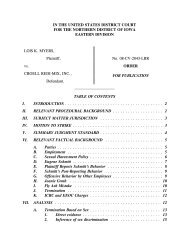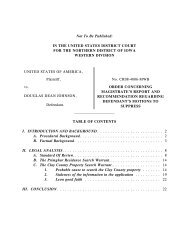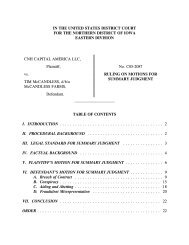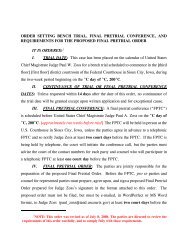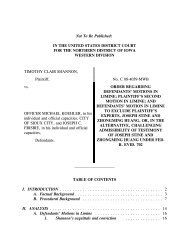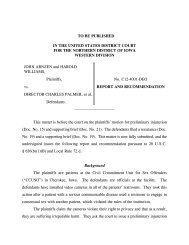IN THE UNITED STATES DISTRICT COURT FOR THE NORTHERN ...
IN THE UNITED STATES DISTRICT COURT FOR THE NORTHERN ...
IN THE UNITED STATES DISTRICT COURT FOR THE NORTHERN ...
You also want an ePaper? Increase the reach of your titles
YUMPU automatically turns print PDFs into web optimized ePapers that Google loves.
<strong>IN</strong> <strong>THE</strong> <strong>UNITED</strong> <strong>STATES</strong> <strong>DISTRICT</strong> <strong>COURT</strong><br />
<strong>FOR</strong> <strong>THE</strong> NOR<strong>THE</strong>RN <strong>DISTRICT</strong> OF IOWA<br />
EASTERN DIVISION<br />
<strong>UNITED</strong> <strong>STATES</strong> OF AMERICA,<br />
vs.<br />
Plaintiff,<br />
ORLANDO BIRBRAGHER,<br />
MARSHALL NEIL KANNER,<br />
DOUGLAS WILLIS BOUCHEY,<br />
ARMANDO ANGULO and PETER<br />
COLON LOPEZ,<br />
No. 07-CR-1023-LRR<br />
ORDER<br />
(<strong>FOR</strong> PUBLICATION)<br />
Defendants.<br />
____________________<br />
TABLE OF CONTENTS<br />
I. <strong>IN</strong>TRODUCTION ....................................... 2<br />
II. RELEVANT PRIOR PROCEED<strong>IN</strong>GS ......................... 2<br />
III. PR<strong>IN</strong>CIPLES OF REVIEW ................................ 4<br />
IV. F<strong>IN</strong>D<strong>IN</strong>GS OF FACT .................................... 6<br />
A. Two Conspiracies .................................. 6<br />
1. Drug conspiracy ............................... 6<br />
2. Money laundering conspiracy ...................... 7<br />
B. Particular Actions .................................. 7<br />
C. Jacqueline Devine ................................. 11<br />
V. ARGUMENTS ........................................ 11<br />
A. Bouchey’s Motion and Kanner’s Motion .................. 11<br />
B. Bouchey’s Supplement .............................. 13<br />
C. Kanner’s Supplement ............................... 13<br />
VI. ANALYSIS .......................................... 14<br />
A. Overview Of Relevant Portions Of CSA ................... 14<br />
B. Void For Vagueness Standard ......................... 16<br />
C. CSA As Applied To Lopez ............................ 16<br />
D. CSA As Applied To Bouchey .......................... 18<br />
E. CSA As Applied To Non-Registrants ..................... 20
F. CSA As Applied To Internet Pharmacies .................. 22<br />
G. Rule Of Lenity ................................... 23<br />
H. Impact of Devine’s Testimony ......................... 24<br />
I. Subjective Standard Or Objective Standard ................. 25<br />
VII. CONCLUSION ....................................... 26<br />
I. <strong>IN</strong>TRODUCTION<br />
The matters before the court are Defendant Douglas Willis Bouchey’s “Motion to<br />
Dismiss Due to Vagueness of Statute, Administrative Regulations; Violation of Due<br />
Process” (“Bouchey’s Motion”) (docket no. 100), “Supplement to [Bouchey’s Motion]”<br />
(“Bouchey’s Supplement”) (docket no. 214), Defendant Marshall Neil Kanner’s “Motion<br />
to Dismiss Due to Vagueness and Violation of Due Process” (“Kanner’s Motion”) (docket<br />
no. 102) and “Motion to Dismiss Indictment” (“Kanner’s Supplement”) (docket no. 207)<br />
(collectively, “Motions”). 1<br />
II. RELEVANT PRIOR PROCEED<strong>IN</strong>GS<br />
On November 7, 2007, a grand jury returned and the government filed a thirty-one<br />
count Indictment (docket no. 2) against Defendant Orlando Birbragher (“Birbragher”),<br />
Marshall Neil Kanner (“Kanner”), Jack Eugene Huzl (“Huzl”), Douglas Willis Bouchey<br />
(“Bouchey”), Armando Angulo (“Angulo”) and Peter Colon Lopez (“Lopez”)<br />
(collectively, “the original defendants”).<br />
Count 1 charged the original defendants with Drug Conspiracy, in violation of 21<br />
U.S.C. §§ 841(a)(1), 841(b)(1)(D), 841(b)(1)(D)(2), 846, 856(a)(1) and 861(a)(1). Count<br />
1 To varying extents, Defendants Orlando Birbragher, Peter Colon Lopez and<br />
Douglas Willis Bouchey join the Motions. See Defendant Birbragher’s “Joinder in Co-<br />
Defendants’ Motions to Dismiss” (docket no. 105), Defendant Lopez’s “Joinder in Co-<br />
Defendant’s [sic] Motions to Dismiss” (docket no. 110), Defendant Birbragher’s “Joinder<br />
in Co[-]Defendant Kanner’s [Supplement]” (docket no. 210), Defendant Birbragher’s<br />
“Joinder in Co[-]Defendant [Bouchey’s Supplement]” (docket no. 215) and Defendant<br />
Bouchey’s “Joinder of Co-Defendant Kanner[’s Supplement]” (docket no. 212). See also<br />
Order (docket no. 121), at 1.<br />
2
2 charged the original Defendants with Money Laundering Conspiracy, in violation of 18<br />
U.S.C. §§ 1956(a)(1)(A)(I), 1956(a)(1)(B)(I), 1956(h) and 1957. 2 Counts 3, 8, 15, 18,<br />
19, 21, 22 & 23 charged Bouchey with Distribution of a Scheduled III or IV Controlled<br />
Substance, in violation of 21 U.S.C. §§ 841(a)(1) and 841(b)(1)(D)(1) or (2). Counts 4,<br />
5, 6, 7, 9, 10, 11, 12, 14, 16, 17 and 20 charged Huzl with the Distribution of a<br />
Scheduled III or IV Controlled Substance, in violation of 21 U.S.C. §§ 841(a)(1) and<br />
841(b)(1)(D)(1) or (2). Counts 24 and 25 charged Huzl with Aiding and Abetting the<br />
Distribution of a Schedule III or IV Controlled Substance to a Minor, in violation of 18<br />
U.S.C. § 2, 21 U.S.C. §§ 841(a)(1), 841(b)(1)(D)(1) or (2) and 859. Counts 26, 27 and<br />
28 charged Huzl with Aiding and Abetting the Distribution of a Schedule III Controlled<br />
Substance, in violation of 18 U.S.C. § 2, 21 U.S.C. §§ 841(a)(1) and 841(b)(1)(D)(1).<br />
Counts 29 and 31 charged Angulo with Distribution of a Schedule III Controlled<br />
Substance, in violation of 21 U.S.C. §§ 841(a)(1) and 841(b)(1)(D)(1). Count 30 charged<br />
Lopez with Distribution and Attempted Distribution of a Schedule III Controlled<br />
Substance, in violation of 21 U.S.C. §§ 841(a)(1), 841(b)(1)(D)(1) and 846. The<br />
Indictment also contains Forfeiture Allegations against the original defendants. Pursuant<br />
to 21 U.S.C. § 853, 18 U.S.C. § 982(a)(1) and Federal Rule of Criminal Procedure<br />
32.2(a), the government seeks approximately $41 million from Birbragher and Kanner,<br />
$103,000 from Huzl, $4,000 from Bouchey, $240,000 from Angulo and $240,000 from<br />
Lopez.<br />
Huzl died shortly after the Indictment. Upon suggestion of his death, the court<br />
dismissed all counts in the Indictment as to him. See Order (docket no. 51), at 1 (granting<br />
Motion to Dismiss (docket no. 47), at 1). That is, the court dismissed Counts 1 and 2 as<br />
to Huzl, and Counts 4-7, 9-12, 14, 16-17, 20 and 24-28 in their entirety. On July 11,<br />
2 On June 9, 2008, the court dismissed Count 2 of the Indictment as to Bouchey.<br />
Order (docket no. 222).<br />
3
2008, Lopez entered a guilty plea (docket no. 244). Further, Angulo is on the lam. Only<br />
Birbragher, Kanner and Bouchey (“the moving defendants”) are presently active<br />
defendants in this case.<br />
On March 31, 2008, Bouchey filed Bouchey’s Motion. On April 1, 2008, Kanner<br />
filed Kanner’s Motion. On April 1, 2008, Birbragher joined Bouchey’s Motion and<br />
Kanner’s Motion. On April 3, 2008, Lopez joined Bouchey’s Motion and Kanner’s<br />
Motion. On April 17, 2008, the government filed an omnibus Resistance to Bouchey’s<br />
Motion and Kanner’s Motion (“Resistance to Bouchey and Kanner Motions”) (docket no.<br />
134). On May 27, 2008, Kanner filed Kanner’s Supplement. On May 27, 2008,<br />
Birbragher joined Kanner’s Supplement. On May 27, 2008, Bouchey joined Kanner’s<br />
Supplement. On May 27, 2008, Bouchey filed Bouchey’s Supplement. On May 28, 2008,<br />
Birbragher joined Bouchey’s Supplement. On June 6, 2008, the government filed an<br />
omnibus Resistance to Kanner’s Supplement (docket no. 219). On June 9, 2008, the<br />
government filed an omnibus Resistance to Bouchey’s Supplement (docket no. 224). On<br />
July 9, 2008, Kanner filed a reply in support of Kanner’s Supplement (docket no. 237).<br />
The court finds a hearing on the Motions is unnecessary. The Motions are fully<br />
submitted and ready for decision.<br />
III. PR<strong>IN</strong>CIPLES OF REVIEW<br />
In the Motions, the moving defendants assert the Indictment is unconstitutionally<br />
vague. The moving defendants argue any conviction under the Indictment would violate<br />
the Due Process Clause of the Fifth Amendment.<br />
The moving defendants ask the court to dismiss the Indictment, pursuant to Federal<br />
Rule of Criminal Procedure 12. 3 In relevant part, Rule 12 provides:<br />
3 The moving defendants do not cite Rule 12, but do not dispute the government’s<br />
assumption of the application of Rule 12 to the Motions. See Brief in Resistance to<br />
Bouchey and Kanner Motions (docket no. 134-11), at 5-6.<br />
4
Rule 12. Pleadings and Pretrial Motions<br />
* * *<br />
(b) Pretrial Motions.<br />
* * *<br />
(2) Motions That May Be Made Before Trial. A party may<br />
raise by pretrial motion any defense, objection, or request that<br />
the court can determine without a trial of the general issue.<br />
(3) Motions That Must Be Made Before Trial. The following<br />
must be raised before trial:<br />
* * *<br />
(B) a motion alleging a defect in the indictment[.]<br />
Fed. R. Crim. P. 12 (emphases in original).<br />
When considering a defendant’s argument for dismissal pursuant to Rule 12, the<br />
court must accept all of the government’s allegations in the charging document as true.<br />
See, e.g., United States v. Sampson, 371 U.S. 75, 78-79 (1962) (“Of course, none of these<br />
charges have been established by evidence, but at this stage of the proceedings the<br />
indictment must be tested by its sufficiency to charge an offense.”); United States v. Kay,<br />
359 F.3d 738, 742 (5th Cir. 2004) (similar). The court must also “make all factual<br />
inferences in favor of the government[.]” United States v. Jeronimo-Bautista, 425 F.3d<br />
1266, 1267 (10th Cir. 2005). As this court stated long ago:<br />
A motion to dismiss the indictment is not a device for a<br />
summary trial of the evidence. The sole function of this<br />
motion is to test the sufficiency of the indictment to charge an<br />
offense. [Sampson, 371 U.S. at 83]. The sufficiency of the<br />
indictment must be determined from the words of the<br />
indictment, and the Court is not free to consider evidence not<br />
appearing on the face of the indictment. In ruling on this<br />
motion, all well-pleaded facts are taken to be true. United<br />
States v. South Florida Asphalt Co., 329 F.2d 860 (5th Cir.<br />
1964); Padilla v. United States, 278 F.2d 188 (5th Cir. 1960).<br />
United States v. Luros, 243 F. Supp. 160, 165 (N.D. Iowa 1965) (Hanson, J.), rev’d on<br />
5
other grounds, 389 F.2d 200 (8th Cir. 1968).<br />
IV. F<strong>IN</strong>D<strong>IN</strong>GS OF FACT<br />
For purposes of the Motions, the court assumes, without deciding, all allegations<br />
in the Indictment are true. Affording the government all reasonable inferences, the facts<br />
are these:<br />
1. Drug conspiracy<br />
A. Two Conspiracies<br />
Between about January of 2003 and continuing until at least May 20, 2004, “in the<br />
Northern District of Iowa and elsewhere,” the original defendants conspired with each<br />
other and other persons to violate the Controlled Substances Act (“CSA”), 21 U.S.C.<br />
§ 801 et seq., in violation of 21 U.S.C. § 846. Indictment at 11. This drug conspiracy<br />
had four objects:<br />
(1) to dispense Schedule III controlled substances outside the usual course<br />
of professional practice and without legitimate medical purpose, in<br />
violation of 21 U.S.C. §§ 841(a)(1) and 841(b)(1)(D).<br />
(2) to dispense Schedule IV controlled substances outside the usual course<br />
of professional practice and without legitimate medical purpose, in<br />
violation of 21 U.S.C. §§ 841(a)(1) and 841(b)[(2)].<br />
(3) to open, lease, rent, use and maintain pharmacy fulfillment centers<br />
for the purpose of distributing Schedule III and IV controlled<br />
substances outside the usual course of professional practice and<br />
without legitimate medical purpose, in violation of 21 U.S.C.<br />
§ 856(a)(1).<br />
(4) to employ, hire, persuade, induce, entice and coerce minors,<br />
including A.B., N.S. and G.L., to violate the CSA, in violation of<br />
21 U.S.C. § 861(a)(1).<br />
Indictment at 11.<br />
6
2. Money laundering conspiracy<br />
Between about January of 2003 and continuing through at least August 9, 2004, “in<br />
the Northern District of Iowa and elsewhere,” the original defendants, excluding Bouchey,<br />
conspired with each other and other persons to conduct and attempt to conduct financial<br />
transactions that involved the proceeds of their unlawful distribution of Schedule III and<br />
IV controlled substances (“the unlawful activity”), in violation in 18 U.S.C. § 1956(h).<br />
Indictment at 22. This money laundering conspiracy had three objects:<br />
Id.<br />
(1) to promote the carrying on of the unlawful activity through the<br />
financial transactions, in violation of 18 U.S.C. § 1956(a)(1)(A)(I).<br />
(2) to conceal and disguise the nature, the source, the ownership, or<br />
the control of the proceeds of the unlawful activity, in violation of 18<br />
U.S.C. § 1956(a)(1)(B)(I).<br />
(3) to engage in monetary transactions of a value greater than $10,000 in<br />
funds derived from the unlawful activity, in violation of 18 U.S.C.<br />
§ 1957.<br />
B. Particular Actions<br />
Birbragher and Kanner owned and operated Pharmacom International Corporation<br />
(“Pharmacom”). Pharmacom used the Internet to sell prescription drugs, including<br />
Schedule III and IV controlled substances. Pharmacom operated www.buymeds.com and<br />
a host of other affiliated websites. 4<br />
4 The affiliated websites included (1) www.buy-alprazolam-online-now.com; (2)<br />
www.buy-codeine-online-now.com; (3) www.buy-darvocet-online-now.com; (4)<br />
www.buy-diazepam-online-now.com; (5) www.buy-fiorinal-online-now.com; (6)<br />
www.buy-hydrocodone-online-now.com; (7) www.buy-lorazepam-online-now.com; (8)<br />
www.buy-lortab-online-now.com; (9) www.buy-norco-online-now.com; (10) www.buyvalium-online-now.com;<br />
(11) www.buy-xanax-online-now.com; (12) www.buy-zydoneonline-now.com;<br />
(13) www.buyhydrocodonefordiscount.com; (14)<br />
(continued...)<br />
7
To purchase controlled substances from Pharmacom, potential customers logged<br />
onto one of Pharmacom’s websites, completed a short health history questionnaire and<br />
provided credit card payment information. Pharmacom did not verify the customers’<br />
identities or require them to submit any medical records as part of the ordering process.<br />
Pharmacom contracted with doctors to review customers’ orders for the prescription<br />
drugs. The doctors approved the orders without examining any of Pharmacom’s customers<br />
and, in the vast majority of cases, without reviewing any medical records. Occasionally,<br />
the doctors emailed or called a customer on the telephone. If the doctor approved an<br />
order, Pharmacom digitally affixed the doctor’s electronic signature to a “prescription.”<br />
Indictment at 13.<br />
For example, Pharmacom employed Lopez as one of its doctors from October of<br />
2003 to April of 2004. Lopez was not licensed to practice medicine anywhere in the<br />
United States. On or about January 8, 2004, Lopez knowingly and intentionally distributed<br />
and dispensed and attempted to distribute and dispense sixty tables of 10mg/500mg<br />
Hydrocodone to M.S., a resident of the Northern District of Iowa.<br />
Pharmacom contracted with pharmacies to fill the “prescriptions.” Id.; see also id.<br />
at 18. Pharmacies downloaded the “prescriptions” from Pharmacom’s website and then<br />
filled and shipped the “prescriptions” to customers throughout the United States. Id.; see<br />
also id. 18. In the vast majority of cases, neither the pharmacy nor the issuing doctors<br />
were located in the same state as the customer.<br />
For example, Pharmacom contracted with Union Family Pharmacy (“Union<br />
Family”) of Dubuque, Iowa, to fill prescription drug orders. From August 18, 2003<br />
through September 12, 2003, Union Family filled at least 4,195 “prescriptions” and<br />
4 (...continued)<br />
www.buypainmeds.com; (15) buyvicodinfordiscount.com; (16)<br />
www.painmedsforless.com; (17) www.painprescriptionsforless.com; (18)<br />
www.needvicodin.com. Indictment at 12.<br />
8
distributed at least 180,430 Schedule III dosage units and at least 53,310 Schedule IV<br />
dosage units. Id. 18. Union Family shipped the vast majority of these “prescriptions”<br />
to customers outside Iowa, even though Union Family was only registered as a pharmacy<br />
in Iowa. Id. Huzl, a licensed pharmacist in Iowa and Colorado, owned and operated<br />
Union Family. Huzl hired Bouchey, a pharmacist licensed in Iowa and Michigan, to fill<br />
Pharmacom’s prescription drug orders. Bouchey was a resident of Iowa.<br />
In August and September of 2003, Bouchey knowingly, intentionally and repeatedly<br />
dispensed Schedule III and IV substances to out-of-state residents. Specifically, Bouchey<br />
dispensed:<br />
(1) sixty tablets of 10mg/500mg Hydrocodone to J.S., a<br />
resident of Utah, on or about August 18, 2003;<br />
(2) sixty tablets of 7.5mg/750mg Hydrocone to W.B., a<br />
resident of California, on or about August 20, 2003;<br />
(3) sixty tablets of 10mg Diazepam to J.D., a resident of<br />
Florida, on or about August 24, 2003;<br />
(4) sixty tablets of 325mg Hydrocodone to P.N., a resident<br />
of Illinois, on or about August 24, 2003;<br />
(5) sixty tablets of 10mg/500mg Hydrocodone to R.N., a<br />
resident of Pennsylvania, on or about August 29, 2003;<br />
(6) thirty tablets of 2mg Alprazolam, a Schedule IV<br />
controlled substance, to R.N., a resident of<br />
Pennsylvania, on or about September 1, 2003;<br />
(7) sixty tablets of 10mg/500mg Hydrocodone to T.P. #1,<br />
a resident of California, on or about September 3,<br />
2003;<br />
(8) sixty tablets of 7.5mg/750mg Hydrocodone to M.J., a<br />
resident of California, on or about September 3, 2003;<br />
and<br />
(9) sixty tablets of 10mg/500mg Hydrocodone to T.P. #2,<br />
a resident of Missouri, on or about September 4, 2003.<br />
Bouchey dispensed all of the foregoing Schedule III and IV controlled substances without<br />
a legitimate medical purpose and outside the course of usual professional practice.<br />
Collectively, Pharmacom’s doctors and pharmacies authorized and filled more than<br />
9
246,000 “prescriptions” for controlled substances. Id. 14. Approximately 80% of the<br />
“prescriptions” were for Hydrocodone, a/k/a Vicodin, Lortab, Lorcet, Norco and Zydone,<br />
a Schedule III controlled substance that is used for pain relief. Id. The remaining 20%<br />
of the “prescriptions” were for Schedule IV controlled substances, such as<br />
Benzodiazepines, Propoxyphene and Phentermine. Id. Pharmacom’s doctors and<br />
pharmacists helped to dispense more than 12.5 million Schedule III dosage units and more<br />
than 1.9 million Schedule IV dosage units. Pharmacom’s customers paid in excess of $40<br />
million for their “prescriptions.” Id.<br />
Pharmacom used the proceeds of its unlawful activity to pay doctors a total of<br />
approximately $2.29 million for authorizing “prescriptions.” Id. 24. Pharmacom paid<br />
a total of approximately $2.26 million to the pharmacies for filling the orders. The funds<br />
deposited into the bank accounts of the doctors and the pharmacies allowed them to<br />
continue operating as critical members of the drug conspiracy. Pharmacom also paid<br />
approximately $7.75 million to acquire the Schedule III and IV controlled substances;<br />
$1.60 million for shipping costs; $3.14 million for marketing costs, including Internet<br />
advertising; and $1.99 million to its employees to help operate its business. These<br />
financial transactions total approximately $19 million.<br />
The original defendants and others acting at their behest conspired to create various<br />
shell corporations to conceal the nature, location, source, ownership and control of the<br />
proceeds from the conspiracy’s unlawful activity. Together, they shifted drug proceeds<br />
to these shell corporations. The shell corporations were almost all Florida corporations,<br />
with the exception of one corporation registered in the U.S. Virgin Islands. Pharmacom<br />
also sent money to various bank accounts or trust accounts controlled by or for the benefit<br />
of the relatives of Birbragher and Kanner.<br />
The original defendants and others working at their behest conducted at least 859<br />
transactions involving $10,000 in drug proceeds.<br />
10
C. Jacqueline Devine<br />
At all times relevant to the instant action, Jacqueline Devine was an<br />
inspector/investigator with the Iowa Board of Pharmacy Examiners. On June 10, 2003,<br />
Ms. Devine inspected Union Family and met with Bouchey about the online pharmacy<br />
business. In her deposition, Ms. Devine was asked whether, at the time of her<br />
investigation, she notified Bouchey or Union Family of any wrongdoing. The relevant<br />
portion of Ms. Devine’s deposition testimony boils down to her stating (1) she did not have<br />
concerns related to shutting down the Internet pharmacy and (2) she lacked authority to<br />
inform Huzl he had to discontinue the Internet pharmacy because there were no regulations<br />
concerning Internet pharmacies at the time she investigated Union Family.<br />
V. ARGUMENTS<br />
The moving defendants argue the Indictment is unconstitutionally vague; they argue<br />
they did not have adequate notice their alleged activities were illegal. Specifically, the<br />
moving defendants contend the key phrases “without a legitimate medical purpose” and<br />
“outside the usual course of professional practice” are (1) not contained in the charged<br />
criminal statutes and (2) not defined in the corresponding administrative regulations. The<br />
moving defendants claim any conviction for the charged conduct would violate the Due<br />
Process Clause of the Fifth Amendment to the United States Constitution.<br />
A. Bouchey’s Motion and Kanner’s Motion<br />
Bouchey summarizes his primary argument as follows:<br />
In August and September 2003, the time of the alleged<br />
offenses, there was great uncertainty as to the legality of online<br />
pharmacies. No federal statute or administrative regulation<br />
directly addressed online pharmacies. Thus, in the instant<br />
prosecution, the government relies upon the undefined<br />
concepts of “legitimate medical purpose” and “outside the<br />
usual course of professional practice” to prosecute the<br />
defendant.<br />
11
The terms “without a legitimate medical purpose” and “outside<br />
the usual course of professional practice” are not defined in the<br />
[CSA]—indeed, the terms are not included anywhere in the<br />
statutes that the defendant is alleged to have violated. The<br />
indictment instead relies upon administrative regulations,<br />
specifically 21 C.F.R. [§] 1306.04(a) (for a prescription to be<br />
effective, the prescription “must be issued for a legitimate<br />
medical purpose by an individual practitioner acting in the<br />
usual course of his professional practice”). However, the<br />
administrative regulations fail to define “legitimate medical<br />
purpose” or “outside the usual course of professional<br />
practice[.]”<br />
Bouchey’s Motion at 6. Further, Bouchey asserts “[h]e could not conform his conduct to<br />
satisfy the laws of online pharmacies, because no one knew what the law was.” Id. at 9.<br />
Bouchey opines the government is not pursuing charges against any other<br />
pharmacists—thereby proving that the government’s interpretation of the CSA leads to<br />
arbitrary enforcement.<br />
argues:<br />
Kanner’s Motion is a nearly verbatim recitation of the same argument. Kanner<br />
At the time of the alleged offense conduct, there was great<br />
uncertainty as to the legality of online pharmacies and to the<br />
requirements of doctors who would prescribe through an<br />
online platform like Pharmacom. There existed no federal<br />
statute nor administrative regulation directly addressing either<br />
the prescribing of drugs by doctors through the internet nor the<br />
fulfillment of those prescriptions by online pharmacies. Thus,<br />
in the instant prosecution, the Government relies upon the<br />
undefined concepts of “legitimate medical purpose” and<br />
“outside the usual course of professional practice” to prosecute<br />
[] Kanner.<br />
The terms “without a legitimate medical purpose” and “outside<br />
the usual course of professional practice” are not defined in the<br />
[CSA]. Indeed, the terms are not included anywhere in the<br />
statutes that the Defendant is alleged to have violated. The<br />
12
Indictment instead relies upon administrative regulations,<br />
specifically, 21 CFR §13.06.04(a) (for a prescription to be<br />
effective, the prescription “must be issued for a legitimate<br />
medical purpose by an individual practitioner acting in the<br />
usual course of his professional practice”). However, the<br />
administrative regulations failed to define “legitimate medical<br />
purpose” or “outside the usual course of professional<br />
practice[.]”<br />
Kanner’s Motion at 3-4. Kanner claims he “could not conform his conduct to satisfy the<br />
laws of online pharmacies[] because no one knew what the law was.” Id. at 7.<br />
In response to Kanner’s Motion and Bouchey’s Motion, the government argues the<br />
distribution of controlled substances through the Internet is not exempt from the CSA and<br />
the facts in the Indictment “do not show that defendants could not have reasonably known<br />
that the law they are charged with breaking applied to their conduct.” Brief in Resistance<br />
to Bouchey and Kanner Motions (docket no. 134-11), at 11.<br />
B. Bouchey’s Supplement<br />
Bouchey’s Supplement purports to “supplement” Bouchey’s Motion with “critical”<br />
deposition testimony from Ms. Devine. Bouchey argues the fact Ms. Devine refrained<br />
from “object[ing] to the online pharmacy during her June 10 visit” shows “no laws or<br />
regulations prohibited [Bouchey’s] conduct[.]” Bouchey’s Supplement at 4-5. Bouchey<br />
concludes this demonstrates the vagueness of the statutes at issue. In response, the<br />
government argues Ms. Devine’s deposition testimony is not relevant to the Motion<br />
because, at the time of Bouchey’s alleged illegal conduct, numerous state and federal<br />
regulations created criminal liability for Bouchey’s actions.<br />
C. Kanner’s Supplement<br />
In Kanner’s Supplement, Kanner rehashes a number of arguments related to<br />
Kanner’s Motion. Additionally, Kanner argues the court should dismiss the Indictment<br />
because the “[g]overnment’s interpretation [of the CSA] is precluded under the principle<br />
of lenity.” Kanner’s Supplement at 1. More specifically, Kanner argues “the<br />
13
[g]overnment’s theory of prosecution is premised upon an arbitrary conclusion that an<br />
online physician questionnaire does not amount to a legitimate physician/patient<br />
relationship.” Id. at 8. In response, the government contends (1) the rule of lenity does<br />
not apply and (2) Kanner’s emphasis on the “Internet” aspect of the moving defendants’<br />
activities is misplaced because the case is not about the propriety of issuing prescriptions<br />
over the Internet, but instead, involves the question of whether Defendants conspired to<br />
distribute controlled substances outside the usual course of medical practice and without<br />
a legitimate medical purpose.<br />
VI. ANALYSIS<br />
A. Overview Of Relevant Portions Of CSA<br />
The CSA defines a “controlled substance” as “a drug or other substance, or<br />
immediate precursor, included in schedule I, II, III, IV, or V of part B of this subchapter.”<br />
21 U.S.C. § 802(6). The placement of a controlled substance within one of the abovereferenced<br />
schedules depends in part on the substance’s “potential for abuse,” whether it<br />
has an “accepted medical use” and whether there is a possibility of physical or<br />
psychological dependence on the controlled substance. Id. § 812(b)(1)-(5). Schedule I<br />
substances have “a high potential for abuse,” a lack of “currently accepted medical use in<br />
treatment in the United States” and “a lack of accepted safety for use of the drug or other<br />
substance under medical supervision.” Id. § 812(b)(1). At the other end of the spectrum<br />
are Schedule V substances, which have “a low potential for abuse relative to the [. . .]<br />
substances in schedule IV,” “a currently accepted medical use in treatment in the United<br />
States” and, in the event of abuse, “may lead to limited physical dependence or<br />
psychological dependence relative to the drugs or other substances in schedule IV.” Id.<br />
§ 812(b)(5). The substances at issue in the instant action, Schedule III and Schedule IV<br />
substances, fall between these two categories. Schedule III substances have less potential<br />
for abuse than Schedule I and II substances, a current accepted medical use in the United<br />
14
States and, in the event of abuse, a “moderate or low physical dependence or high<br />
psychological dependence.” Id. § 812(b)(3). Schedule IV substances have a smaller risk<br />
for potential abuse than Schedule III substances, an accepted medical use and, if abused,<br />
“may lead to limited physical dependence or psychological dependence relative to the<br />
drugs or other substances in schedule III.” Id. § 812(b)(4).<br />
Section 841 of the CSA provides: “it shall be unlawful for any person knowingly<br />
or intentionally [. . .] to manufacture, distribute, or dispense, or possess with intent to<br />
manufacture, distribute, or dispense, a controlled substance[.]” Id. § 841(a)(1). However,<br />
a person may lawfully distribute or dispense a controlled substance by issuing a<br />
“prescription,” which is “an order for medication which is dispensed to or for an ultimate<br />
user[.]” 21 C.F.R. § 1300.01(b)(35). Section 1306.04(a) sets forth the parameters for the<br />
lawful issuance of a controlled substance pursuant to a prescription and provides:<br />
A prescription for a controlled substance to be effective must<br />
be issued for a legitimate medical purpose by an individual<br />
practitioner acting in the usual course of his professional<br />
practice. The responsibility for the proper prescribing and<br />
dispensing of controlled substances is upon the prescribing<br />
practitioner, but a corresponding responsibility rests with the<br />
pharmacist who fills the prescription. An order purporting to<br />
be a prescription issued not in the usual course of professional<br />
treatment or in legitimate and authorized research is not a<br />
prescription within the meaning and intent of section 309 of<br />
[the CSA] and the person knowingly filling such a purported<br />
prescription, as well as the person issuing it, shall be subject<br />
to the penalties provided for violations of the provisions of law<br />
relating to controlled substances.<br />
21 C.F.R. § 1306.04(a) (emphases added). The moving defendants contend the CSA as<br />
applied to them is unconstitutionally vague because the CSA does not contain the language<br />
“legitimate medical purpose” and “usual course of his professional practice” and because<br />
these phrases are not defined in the CSA or the applicable regulations.<br />
15
B. Void For Vagueness Standard<br />
“The Fifth Amendment guarantees every citizen the right to due process. Stemming<br />
from this guarantee is the concept that vague statutes are void.” United States v. Washam,<br />
312 F.3d 926, 929 (8th Cir. 2002) (citing Connally v. Gen. Constr. Co., 269 U.S. 385,<br />
391 (1926)). “An overly vague statute ‘violates the first essential of due process of law,’<br />
because citizens ‘must necessarily guess at its meaning and differ as to its application.’”<br />
United States v. Bamberg, 478 F.3d 934, 937 (8th Cir. 2007) (quoting Connally, 269 U.S.<br />
at 391). “A statute which either forbids or requires the doing of an act in terms so vague<br />
that men of common intelligence must necessarily guess at its meaning and differ as to its<br />
application, violates the first essential of due process of law.” Washam, 312 F.3d at 929<br />
(internal citations omitted). “‘Void for vagueness simply means that criminal<br />
responsibility should not attach where one could not reasonably understand that his<br />
contemplated conduct is proscribed.’” Id. (quoting United States v. Nat’l Dairy Prods.<br />
Corp., 372 U.S. 29, 32-33 (1963)). “There is a two-part test to determine whether a<br />
statute is void for vagueness. The statute, first, must provide adequate notice of the<br />
proscribed conduct, and second, not lend itself to arbitrary enforcement.” Bamberg, 478<br />
F.3d at 937 (citing Kolender v. Lawson, 461 U.S. 352, 357 (1983)); see also Washam, 312<br />
F.3d at 929 (8th Cir. 2002) (similar).<br />
C. CSA As Applied To Lopez 5<br />
The court first considers whether the CSA is unconstitutionally vague as applied to<br />
Lopez, a physician. The Supreme Court considered this issue in United States v. Moore,<br />
423 U.S. 122 (1975). Moore held a physician could be charged with criminal conduct<br />
under the CSA for dispensing drugs outside the usual course of the physician’s medical<br />
5 Although Lopez entered a guilty plea, thereby giving up his right to litigate this<br />
issue, the court will nevertheless analyze the void for vagueness challenge as to his<br />
involvement because it is necessarily intertwined with the conduct of the moving<br />
defendants.<br />
16
practice. Moore, 423 U.S. at 124 & 140-42. The illegal conduct for which the physician<br />
in Moore was found guilty is similar to the conduct alleged in the Indictment:<br />
[H]e gave inadequate physical examinations or none at all. He<br />
ignored the results of the tests he did make. He did not give<br />
methadone at the clinic and took no precautions against its<br />
misuse and diversion. He did not regulate the dosage at all,<br />
prescribing as much and as frequently as the patient demanded.<br />
He did not charge for medical services rendered, but graduated<br />
his fee according to the number of tablets desired. In practical<br />
effect, he acted as a large-scale “pusher[,]” not as a physician.<br />
Id. at 142-43.<br />
Other courts have held this provision is not unconstitutionally vague. In United<br />
States v. Collier, 478 F.2d 268 (5th Cir. 1973), the Fifth Circuit Court of Appeals<br />
considered whether the CSA was unconstitutionally vague as applied to a physician. More<br />
specifically, Collier considered whether the phrase “in the course of his professional<br />
practice” was vague. Collier, 478 F.2d at 270-71. The court held the provision was not<br />
unconstitutionally vague, stating “statutes affecting medical practice need not delineate the<br />
precise circumstances constituting the bounds of permissible practice.” Id. at 272. Since<br />
Collier, courts have continued to apply this standard to physicians and other medical<br />
professionals. See United States v. Tran Tron Cuong, 18 F.3d 1132, 1137 (4th Cir. 1994)<br />
(“a licensed physician who prescribes controlled substances outside the bounds of his<br />
professional medical practice is subject to prosecution and is no different than a large-scale<br />
‘pusher.’”) (quoting Moore, 423 at 143); United States v. DeBoer, 966 F.2d 1066, 1068-<br />
69 (6th Cir. 1992) (denying void-for-vagueness challenge to 21 U.S.C. § 841(a)(1) and<br />
21 C.F.R. § 1306.04(a) because a pharmacist’s responsibilities giving rise to unlawful<br />
conduct was “clearly define[d]” in 21 C.F.R. § 1306.04(a)); United States v. Roya, 574<br />
F.2d 386, 390-91 (7th Cir. 1978) (rejecting argument suggesting CSA was<br />
unconstitutionally vague as applied to the defendant-physician); United States v.<br />
Rosenberg, 515 F.2d 190, 197 (9th Cir. 1975) (holding same); United States v. Prejean,<br />
17
429 F. Supp. 2d 782, 805 (E.D. La. 2006) (holding the language “legitimate medical<br />
purpose” and “professional practice” is not unconstitutionally void).<br />
The government also cites approximately twenty other decisions from the circuit<br />
courts of appeals affirming convictions against physicians under the CSA for facts similar<br />
to those alleged in the instant action, such as issuing prescriptions without first examining<br />
the patient, issuing a prescription after an inadequate patient evaluation, only charging a<br />
patient for services when a prescription is written, issuing prescriptions for a particular<br />
controlled substance the patient either named or described and writing an unusually large<br />
number of prescriptions. See Brief in Resistance to Bouchey and Kanner Motions at 15-<br />
16.<br />
In contrast, the moving defendants cite no case law supporting their position. The<br />
court does not see any reason to depart from the overwhelming body of case law finding<br />
the CSA constitutional as applied to physicians for issuing prescriptions without a<br />
“legitimate medical purpose” and outside the “usual course of [the physician’s]<br />
professional practice” for conduct similar to that alleged in the Indictment. The court finds<br />
the relevant portions of the CSA and accompanying regulations provide physicians with<br />
adequate notice of the proscribed conduct and also finds the CSA does not lend itself to<br />
arbitrary enforcement. Bamberg, 478 F.3d at 938. Therefore, the court would deny the<br />
Motions to the extent they ask the court to find the CSA unconstitutional as applied to<br />
Lopez.<br />
D. CSA As Applied To Bouchey<br />
Next, the court considers whether the CSA is constitutional as applied to Bouchey,<br />
a pharmacist. The CSA applies to pharmacists in addition to physicians. See United States<br />
v. Limberopoulos, 26 F.3d 245, 249 (1st Cir. 1994) (“well-established case law mak[es]<br />
clear that the [CSA] applies to a pharmacist’s [. . .] drug-dispensing activities so long as<br />
they fall outside the usual course of professional practice”). A pharmacist can be charged<br />
18
with criminal conduct under the CSA for filling a prescription without “a legitimate<br />
medical purpose” or outside the “usual course of his professional practice.” 21 C.F.R.<br />
§ 1306.04(a) (“The responsibility for the proper prescribing and dispensing of controlled<br />
substances is upon the prescribing practitioner, but a corresponding responsibility rests<br />
with the pharmacist who fills the prescription.”). “Thus, a pharmacist may not fill a<br />
written order from a practitioner, appearing on its face to be a prescription, if he knows<br />
the practitioner issued it in other than the usual course of medical treatment. The<br />
regulation gives ‘fair notice that certain conduct is proscribed.’” United States v. Hayes,<br />
595 F.2d 258, 260 (5th Cir. 1979) (quoting Rabe v. Washington, 405 U.S. 313, 315<br />
(1972)).<br />
As set forth above, courts have held the language “legitimate medical purpose” and<br />
“usual course of his professional practice” is not unconstitutionally vague as applied to<br />
physicians. The court does not see, and the moving defendants have not offered, a<br />
rationale by which it could conclude this language is constitutional as applied to physicians<br />
but unconstitutional as applied to pharmacists. Moreover, previous challenges by<br />
pharmacists to the constitutionality of the CSA on vagueness grounds have failed. See id.<br />
at 260-61 (rejecting vagueness challenge as to pharmacist); United States v. Hernandez,<br />
No. 07-60027-CR, 2007 WL 2915854, *9 (S.D. Fla. Oct. 4, 2007) (denying motion to<br />
dismiss indictment for CSA violations on vagueness grounds as applied to Internet<br />
pharmacy owners, operators, physicians and pharmacists). Finally, the government cites<br />
a number of cases showing pharmacists have routinely been prosecuted for violations of<br />
the CSA when acting outside the usual course of professional practice. See Brief in<br />
Resistance to Bouchey and Kanner Motions at 17-19. Such cases include United States v.<br />
Kershman, 555 F.2d 198, 202 (8th Cir. 1977) (finding sufficient evidence supported<br />
conviction of pharmacist under CSA); United States v. Steele, 178 F.3d 1230, 1232 &<br />
1241 (11th Cir. 2000) (affirming conviction of pharmacist under CSA for filling<br />
19
prescriptions he knew to be forged). In contrast, the moving defendants set forth no<br />
authority supporting their proposition that the CSA is unconstitutionally vague as applied<br />
to pharmacists.<br />
The moving defendants also argue the unconstitutional nature of the CSA is<br />
evidenced by the fact Bouchey and Huzl are “the only pharmacists to be prosecuted by the<br />
federal government in the United States for their alleged involvement in dispensing<br />
medications from online prescriptions.” Bouchey’s Motion at 9. This is incorrect.<br />
example, the Fifth Circuit Court of Appeals upheld the conviction of a licensed pharmacist<br />
for conspiracy to distribute controlled substances under the CSA as a part of an Internet<br />
pharmacy. United States v. Fuchs, 467 F.3d 889, 909 (5th Cir. 2006), cert denied, 127<br />
S. Ct. 1502 (2007). Further, the government cites eight other cases where a pharmacist<br />
has been prosecuted for filling online prescriptions. See Brief in Resistance to Bouchey<br />
and Kanner Motions at 19.<br />
For<br />
Even if Bouchey and Huzl were the only pharmacists<br />
prosecuted under the CSA, that fact would lend nothing to this analysis and would not be<br />
relevant.<br />
Accordingly, the court finds the relevant portions of the CSA and applicable<br />
regulations provide pharmacists with adequate notice of the proscribed conduct and also<br />
finds the CSA does not lend itself to arbitrary enforcement of the CSA as to pharmacists.<br />
Bamberg, 478 F.3d at 938. Therefore, the court shall deny the Motions to the extent they<br />
ask the court to find the CSA is unconstitutionally vague as applied to Bouchey.<br />
E. CSA As Applied To Non-Registrants<br />
The moving parties allege the CSA is unconstitutionally vague as applied to nonregistrants<br />
Birbragher and Kanner. 6 More specifically, the moving parties argue the<br />
6 Every person who manufactures, distributes or dispenses a “controlled substance”<br />
must obtain a registration from the Attorney General. 21 U.S.C. § 822(a). Under this<br />
statute, Bouchey and Lopez are registrants. “Non-registrants” include those who are not<br />
(continued...)<br />
20
absence of a definition of “legitimate medical purpose” and “usual course of his<br />
professional practice” prevented the non-registrant defendants from “conforming [] [their]<br />
conduct to satisfy the laws of online pharmacies, because no one knew what the law was.”<br />
Kanner’s Motion at 7. However, aside from arguing conduct involving online pharmacies<br />
somehow distinguishes the moving defendants from precedent finding the CSA<br />
constitutional as applied to non-registrants, the moving defendants offer no new argument<br />
to show the CSA is void for vagueness as applied to the non-registrant defendants.<br />
Courts have considered and rejected void for vagueness challenges to the application<br />
of the CSA to non-registrants. See DeBoer, 966 F.2d at 1067-69 (rejecting void for<br />
vagueness argument by CSA defendant who “functioned as both a manager and a<br />
pharmacy technician” in the illegal distribution of cough syrup); Prejean, 429 F. Supp. 2d<br />
at 804-05 (affirming conviction of non-registrant owner of pharmacy in CSA conspiracy<br />
and rejecting void-for-vagueness arguments).<br />
Additionally, non-registrants have been charged and convicted under the CSA for<br />
conduct similar to that alleged in the Indictment. See United States v. Vamos, 797 F.2d<br />
1146, 1153-54 (2d Cir. 1986) (finding it appropriate to charge nurse and office manager<br />
in CSA conspiracy); United States v. Albert, 675 F.2d 712, 715-16 (5th Cir. 1982)<br />
(holding registrants can conspire with non-registrants to dispense drugs illegally under<br />
CSA so long as the non-registrants knowingly participate in the conspiracy with a<br />
registrant); Hernandez, 2007 WL 2915854 at *9 (denying motion to dismiss indictment for<br />
CSA violations on vagueness grounds as applied to Internet pharmacy owners, operators,<br />
physicians and pharmacists).<br />
The court agrees with the authority rejecting vagueness challenges to the CSA as<br />
6 (...continued)<br />
registered to manufacture, distribute or dispense a controlled substance—Kanner and<br />
Birbragher.<br />
21
to non-registrants and affirming convictions against non-registrants for violations under the<br />
CSA. The moving defendants have provided no persuasive reason for the court to depart<br />
from this authority. The court finds the non-registrants had adequate notice of the<br />
proscribed conduct and also finds the CSA does not lend itself to arbitrary enforcement of<br />
the CSA as to non-registrants. Bamberg, 478 F.3d at 938. Accordingly, the court shall<br />
deny the Motions to the extent they ask the court to find the CSA is unconstitutionally<br />
vague as applied to Kanner and Birbragher.<br />
F. CSA As Applied To Internet Pharmacies<br />
In Kanner’s Supplement, Kanner challenges the propriety of prosecuting Internet<br />
pharmacies, proclaiming “the fundamental question raised by this prosecution is whether<br />
it is lawful to sell prescription medicine through the [I]nternet, where the patient in need<br />
of the medication and the physician never meet face to face.” Kanner’s Supplement at 2.<br />
Kanner refers to “a national debate on the wisdom of providing medicine by way of the<br />
[I]nternet,” and claims the prosecution of Internet pharmacies has resulted in “the<br />
government [making] criminals out of persons who never intended to break the law[.]”<br />
Id. at 6. Additionally, Kanner argues “[t]he [g]overnment’s theory of prosecution is<br />
premised upon an arbitrary conclusion that an online physician questionnaire does not<br />
amount to a legitimate physician/patient relationship.” Id. at 8.<br />
Kanner misses the point. The Indictment seeks to prosecute individuals who<br />
conspired to commit actions violating the CSA by dispensing controlled substances without<br />
a “legitimate medical purpose” and “outside the course of [the physician’s] professional<br />
practice.” The fact the alleged criminal conduct occurred through Internet transactions is<br />
irrelevant. Moreover, district courts have applied the CSA to convict defendants involved<br />
in illegal distribution of controlled substances through the Internet. See Hernandez, 2007<br />
WL 2915854 at *9 (denying motion to dismiss indictment for CSA violations on vagueness<br />
grounds as applied to Internet pharmacy owners, operators, physicians and pharmacists);<br />
22
Fuchs, 467 F.3d at 905 (affirming convictions for CSA violations arising from Internet<br />
prescription business). The fact the Indictment seeks to convict defendants involved in<br />
alleged illegal conduct arising from an Internet pharmacy as opposed to a “brick and<br />
mortar” pharmacy does not render the Indictment defective.<br />
G. Rule Of Lenity<br />
In Kanner’s Supplement, Kanner also argues the court should dismiss the Indictment<br />
pursuant to the rule of lenity. 7<br />
The rule of lenity requires ambiguous criminal laws to be<br />
interpreted in favor of the defendants subjected to them. This<br />
venerable rule not only vindicates the fundamental principle<br />
that no citizen should be held accountable for a violation of a<br />
statute whose commands are uncertain, or subjected to<br />
punishment that is not clearly prescribed. It also places the<br />
weight of inertia upon the party that can best induce Congress<br />
to speak more clearly and keeps courts from making criminal<br />
law in Congress’s stead.<br />
United States v. Santos, 128 S. Ct. 2020, 2025 (2008) (internal citations omitted).<br />
However, the rule of lenity only requires a court to “adopt the less punitive alternative if<br />
faced with two reasonable interpretations of a criminal statute and ambiguous<br />
congressional intent.” United States v. Brummels, 15 F.3d 769, 773 (8th Cir. 1994)<br />
(citing United States v. Freisinger, 937 F.2d 383, 391 (8th Cir. 1991) (emphasis in<br />
Brummels)). “‘The mere possibility of articulating a narrower construction [. . .] does not<br />
by itself make the rule of lenity applicable.’” Id. (quoting Smith v. United States, 508<br />
U.S. 223, 239 (1993)). The court finds the moving defendants’ alleged criminal conduct<br />
falls well within a reasonable interpretation of the CSA. In contrast, the interpretation of<br />
the CSA the moving defendants urge the court to adopt is not a reasonable one. As stated<br />
7 Kanner’s Supplement makes other arguments; however, they either re-hash or<br />
restate arguments discussed in Kanner’s Motion. The court need not repeat its conclusion<br />
in response to these repetitive arguments.<br />
23
in United States v. Quinones, 536 F. Supp. 2d 267 (E.D.N.Y. 2008):<br />
[A] reasonable person reading § 841(a)(1) is on notice that<br />
distributing controlled substances is illegal unless it fits within<br />
the exception; it is not too great a burden to require that person<br />
to investigate the extent of the exception before plunging<br />
ahead. Put another way, it is disingenuous that the moving<br />
defendants seek to invoke the exception as legalizing their<br />
actions, but then claim they do not know what the exception<br />
means.<br />
Id. at 274. The court agrees with Quinones. It would be unfair for the moving defendants<br />
to have initially justified their online pharmacy business by claiming the statutory<br />
“prescription” exception applied to them, then later argue they did not know what the<br />
statutory “prescription” exception meant.<br />
In what appears to be support for his rule of lenity argument, Kanner notes<br />
Congress failed to pass a proposed bill: (1) requiring Internet pharmacy websites “to<br />
identify the business, physician, and pharmacist associates with the website and state where<br />
the person is authorized by law to prescribe or dispense prescription drugs”; and (2)<br />
“prohibiting a website from referring a customer to a doctor who then writes a prescription<br />
without ever seeing the patient.” Kanner’s Supplement at 8 (citing H.R. 840, 109th Cong.<br />
(2005)). Kanner states the fact this bill failed to pass means “the government cannot be<br />
permitted to do what [C]ongress has itself thus far refused.” Id. The fact this bill has not<br />
passed does not render the CSA unconstitutional as applied to Internet pharmacies. As set<br />
forth above, courts consistently reject constitutional challenges to the CSA on vagueness<br />
grounds even in the absence of a law such as the proposed bill summarized above,<br />
including prosecutions involving Internet pharmacies. The rule of lenity does not operate<br />
to render the CSA inapplicable or unconstitutional as applied to the moving defendants.<br />
H. Impact Of Devine’s Testimony<br />
In Bouchey’s Supplement, Bouchey argues the fact Devine “lodged no objections<br />
to the online pharmacy during her June 10 visit [. . .] to Union Family” demonstrates the<br />
24
vague state of the statutes and regulations at issue in the Motions. Bouchey’s Supplement<br />
at 4. Bouchey states: “[b]ecause no laws or regulation prohibited the defendant’s conduct<br />
in 2003, as evidenced by [Devine]’s testimony, the instant prosecution violates the due<br />
process clause of the United States Constitution.” Id. at 5. However, active state and<br />
federal regulations governed the moving defendants’ activities at the time Ms. Devine<br />
investigated Union Family. Although these regulations were not specifically targeted<br />
toward Internet pharmacies, they nevertheless regulated the moving defendants’ conduct.<br />
As discussed above, these federal regulations required a physician or pharmacist to issue<br />
prescriptions “for a legitimate medical purpose” by a practitioner “in the usual course of<br />
his professional practice.” See 21 C.F.R. § 1306.04(a). The court has already found<br />
these regulations sufficient to put the moving defendants on notice of the proscribed<br />
conduct at issue. Additionally, the Iowa Administrative Code provided parallel governance<br />
on these issues. See Iowa Admin. Code r.657-8.19(4) (2008) (stating a “pharmacist shall<br />
ensure the prescription drug [. . .] has been issued for a legitimate medical purpose by an<br />
authorized practitioner acting in the usual course of the practitioner’s professional<br />
practice”). The fact Ms. Devine did not raise these issues does not render the CSA<br />
unconstitutional as applied to the moving defendants.<br />
I. Subjective Standard Or Objective Standard<br />
Finally, in Kanner’s Reply to Government’s Omnibus Resistance to Defendant’s<br />
[sic] Motion to Dismiss Indictment (Kanner’s Reply) (docket no. 237), Bouchey argues<br />
§ 1306.04(a) should apply a subjective standard rather than an objective standard to<br />
determine whether a physician acted in “the usual course of his professional practice.”<br />
Bouchey argues the government’s failure to include the word “his” in reference to a<br />
physician’s “professional practice” in the government’s argument, Indictment and other<br />
proceedings means the Indictment fails to state a crime because it abrogates this subjective<br />
standard.<br />
25
A great weight of authority holds otherwise. “[A]llowing criminal liability to turn<br />
on whether the defendant-doctor complied with his own idiosyncratic view of proper<br />
medical practices is inconsistent with” Supreme Court precedent. United States v.<br />
Hurwitz, 459 F.3d 463, 478 (4th Cir. 2006) (citing Moore, 423 U.S. at 124); see also<br />
Hayes, 794 F.2d at 1351 (affirming conviction where district court instructed “[g]ood faith<br />
is not merely a doctor’s sincere intention towards the people who come to see him, but,<br />
rather, it involves his sincerity in attempting to conduct himself in accordance with a<br />
standard of medical practice generally recognized and accepted in the country”); United<br />
States v. Norris, 780 F.2d 1207, 1209 (5th Cir. 1986) (rejecting argument suggesting good<br />
faith instruction should reflect subjective rather than objective standard). Indeed, one of<br />
the cases Kanner cites in support of his subjective standard argument applies an objective<br />
standard. See Kanner’s Reply at 2 (citing United States v. Voorhies, 663 F.2d 30, 34 (6th<br />
Cir. 1981) (affirming conviction where jury was instructed, “Good faith [. . .] means good<br />
intentions and honest exercise of best professional judgment as to a patient’s medical<br />
needs. It connotes an observance of conduct in accordance with what the physician should<br />
reasonably believe to be proper medical practice.”) (emphasis added)). Any omission of<br />
a subjective standard in the Indictment clearly does not warrant dismissal of the<br />
Indictment.<br />
VII. CONCLUSION<br />
The Motions (docket nos. 100, 102, 207 and 214) are DENIED. The time between<br />
the filing of the Motion and the date of this Order is hereby excluded from calculation<br />
under the Speedy Trial Act. 18 U.S.C. § 3161(h)(1)(F) (excluding delay resulting from<br />
the filing of any pretrial motion through the conclusion of the hearing thereon); id.<br />
§ 3161(h)(1)(J) (excluding “delay reasonably attributable to any period, not to exceed<br />
thirty days, during which any proceeding concerning the defendant is actually under<br />
advisement by the court”).<br />
26
IT IS SO ORDERED.<br />
DATED this 22nd day of July, 2008.<br />
27



